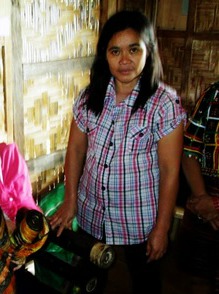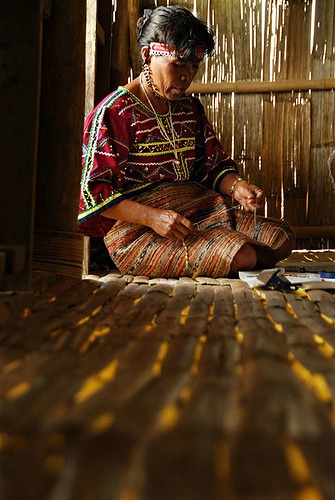Filtered By: Opinion
Opinion
Weaving dreams
By LILA RAMOS SHAHANI
It is a study in contrast: the majestic, rural sky of Mt. Apo presiding over the Bagobo-Tagabawa’s austere existence. Today, their ancestral lands no longer yield enough produce to sustain them, making life a constant struggle. Given the remoteness of Davao del Sur, they have now been eclipsed by a world rife with modern technology.
Indigenous peoples (IPs) are among the poorest and most marginalized sectors in Philippine society. The Asian Development Bank reported that regions with the highest concentrations of IPs, in view of their remoteness, receive the smallest allocations from the national government, although this has increased steadily in recent years. Still, social service provisions in indigenous territories are far below that of the rest of the country.


Vivencia Mamites is one of five women who have been taught how to weave inabal, the traditional cloth of the Bagobo-Tagabawa ancestral royalty. Echosi Facebook page
Vivencia Mamites, 49, has become experienced in coping with these spartan conditions. She used to sell native foods at the market to augment her family’s income, doubling up as a dressmaker too—at least whenever her neighbors made orders. Despite all of these efforts, her income barely made a dent on her family’s endless financial needs.
Her husband is a farmer, but his meager holding has difficulty thriving without irrigation. Relying heavily on the vagaries of the weather, their harvest is unpredictable, making for an income both fraught and unstable.
Adding to the pressures of their daily lives is the need to support their three children, one of whom is in elementary; the other two, of college age, have never been to university.
This situation is reflective of the state of IPs all over the country. A 2004 Task Force Indigenous People study conducted in eight indigenous communities showed that one out of three indigenous children entering primary school would most likely drop out and fail to graduate. Their chance of availing of a secondary school education was around 27 percent, and completing it, a mere 11 percent. College education appears to be out of reach for most of them, with just about a 6 percent chance.
Despite these stark realities, Vivencia has not wavered in her goal to provide more for her children. When she heard of a better opportunity to improve her lot by weaving textiles, she did not hesitate to learn the skill.


Brightly-colored traditional textiles sharply contrast with the Bagobo-Tagabawa's austere existence. nickilo.wordpress.com
She has since become one of only five women to whom the knowledge and technique of weaving inabal, a traditional cloth used by Bagobo-Tagabawa ancestral royalty, has been handed down.
She acquired the skills from Salinta Monon, a Gawad Manlilikha ng Bayan recipient. In 1998, the National Commission for Culture and the Arts presented its National Living Treasure Award to Monon to celebrate the work of indigenous artists like her. Monon is widely recognized for her world-renowned weaves of traditional Bagobo-Tagabawa textiles. Dubbed the “last Bagobo weaver,” she patiently preserved an art that was once on the verge of extinction.
Why women?
In turn, the Philippine Commission on Women (PCW), the Echosi Foundation and the Canadian Government decided to help women weavers like Vivencia become entrepreneurs: they sought not only to enhance the quality of specific entrepreneurial products by women; they also linked them up with local and export markets.
In 2012, they held an Intensive Design Clinics Series with local government units, as well as the Department of Trade and Industry and the Department of Science and Technology. After conducting training sessions with over a thousand women in 37 different municipalities, they chose 30 promising women micro-entrepreneurs for the “Great Women” brand. It was through these seminars that Vivencia learned to improve her designs and expand her client base.
Once the design clinics were completed, the PCW and Echosi made the “Great Women” brand public in March 2013. Through the Echosi’s Echo Store, people can now buy the specialty products of women entrepreneurs from all over the country, which feature such products as crab paste, flavored nuts and textiles.


Inabal weaving enables Bagobo-Tagabawa women to improve their quality of life in their communities. Lawrence Joy dela Fuente
Behind the PCW and Echosi Foundation’s decision to channel aid to women entrepreneurs is the widely-recognized fact that, when more women play an active role in the formal labor market, there is a corresponding increase in national production and earnings. The expansion of women’s economic participation does more than realize greater financial returns. There is ample evidence to suggest that gender equality corresponds to lower poverty rates.
It is not surprising that the focus has been on medium and small businesses, as well as microenterprises (MSMEs). These are considered to be a leading engine of job creation in the Philippines, making for 61.2 percent of the country’s total employment. Women own six out of 10 of these businesses, which are often in retail trade, food cart vending, and home-based food processing.
Great Women
The Great Women brand demonstrates how, given sufficient support, poor women can create high-quality, world-class products. Vivencia, whose inabal weavings are already being used by couture designers, is living proof. Today, she looks forward to being able to send at least her youngest child to university.
As leader of the Tribal Women’s Weaver Association, she inspires other women to take an active role in their own financial security. Recently, she encouraged her friend, Estela Barra, 56, to take up weaving as well. A former housewife, Estela is now part of the weaver association and actively teaches other women to become entrepreneurs.
Soon they will receive P200,000 from the Department of Labor and Employment to expand their micro-enterprise, which also plans to venture into bag- and dress-making.
Vivencia exemplifies the multiplier effect of economic empowerment: it is not limited to giving women better financial prospects; it extends to other facets of community and national development altogether. In this case, these gains also help preserve our cultural heritage.


The Great Women Project conducted several capacity-building seminars for indigenous women entrepreneurs. Echosi Facebook Page
Phase I of the Great Women Project successfully concluded last year. Phase II (2014-2020) of the project has already been given $8 million (CAD) in financial aid by the Canadian Government. This phase will target about 25 percent (or 11,500) of an estimated 46,000 women micro-enterprises in food and woven cloth sub-sectors. These exciting prospects bode well for many women entrepreneurs in the coming year.
Other barriers
Vivencia’s story gives us hope, but the big picture is less rosy for the majority of poor women. Social, financial and educational barriers that hinder the productivity of poor women continue to persist.
Time management is often cited as a leading hindrance for women running businesses: women (especially among less educated, lower income groups) are still expected to perform the majority of household tasks, including child-rearing.
Clearly, traditional gender roles are an additional challenge for many, but studies show that economically active women are more likely than men to invest their resources in their children’s health and education. Simply put, their economic participation benefits their families in very direct ways.
Ultimately, inclusive growth will remain impossible without economically empowering half of the world’s population. Projects geared towards improving women’s role in the national and global economy are therefore critical.
Although not all women have had the support Vivencia received, stories like hers continue to provide inspiration. Much remains to be done to economically enable women, but projects like the Great Women brand help women shape their own destinies towards a more empowered future.
For more information, please see: http://www.echostore.ph/
Assistant Secretary Lila Ramos Shahani is Head of Communications of the Human Development and Poverty Reduction Cabinet Cluster, which covers 26 government agencies dealing with poverty and development. She would like to thank Sarah G. Crespo for her help with this piece.
More Videos
Most Popular




